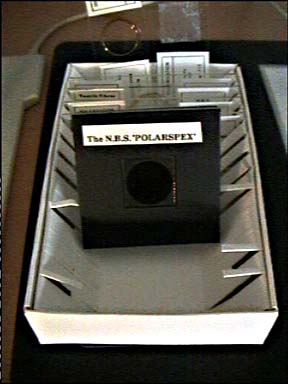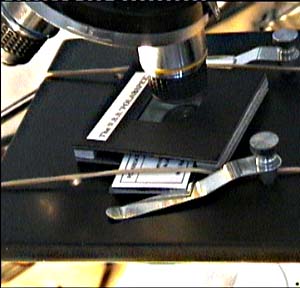

A good idea |
Use household stuff |
The right way! |
You can skip this if yer don't want details! |
A secret unlocked! |
| Polarized Light Illumination
(cross polars)
Light is strange stuff! What is it: waves, rays, photons, particles - all of these? We don't really need to know. All we need to understand is how light behaves when passing through, or refracting, reflecting from, our specimens under the microscope. Many subjects are so transparent that they are extremely difficult to observe using normal lighting techniques but it is possible to use filters to help introduce color, and therefore detail, into these specimens. We are all familiar with sun glasses. Good ones use lenses that reduce glare and reflection by exploiting the properties of 'polarizing' materials. Loosely explained - what polarizing filters do is to confine light wave vibrations to certain directions : a plane! If we introduce one piece of polarizing material into our light cone, we effectively inhibit some of the light rays (waves?) so that the ones passing through are lined up in a specific [equal] plane. If we then introduce a second piece of polarizing material into our light cone and rotate it, when the second one is fully rotated 90 degrees with the first - all light will be obscured and prevented from passing through the second piece of material. We can use this knowledge and basic model of light to good effect in microscopy. If we place our first piece of material below the specimen slide and the second piece above it (rotated 90%), then something amazing happens with certain specimens. If the specimen contains processes and material that refracts and distorts light significantly enough to change its plane (direction of vibration), the light emerging from the specimen from these areas will shift plane relative to the other waves. Upon encountering the second piece of polarizing material (placed above the specimen) they will continue to pass through instead of being blocked. Remember - the second piece of polarizing material is aligned to block light travelling in a certain plane in the cone: any light not restricted to this plane will simply pass through! This technique is known as viewing specimens in 'cross-polars'. Many microscopes come with a polarizer and analyser built in. The 'analyser' being a reference to the top piece of material, and the polarizer being the lower (under the specimen) piece of material. They are often marked up as more expensive microscopes.
This is what you would be purchasing should you wish to buy one instead of making your own:-  
Here are some examples of slides with and without cross-polarization:- Benzoic Acid
Animal Hairs
Urea
There are other ways to interfere with that all-important cone of light. I have summarized some other techniques on the next page but really these two (dark-ground and cross-polar) are the basic ones most important to you! Please note: I am intentionally using a mix of United States English spelling and UK English spelling in me (my) stuff here. I kinda (kind of) guess that if my Microscopy friends in the states can take the time to read me stuff and put up with me funny grammar, then I can at least try and use some american spelling on some words when I know them. One thing I like about American English is that many words containing the word part 'ise' (to polarise, to utilise) use the correct and true form of this - which is 'ize'. The word part is derived from the Greek word 'izein' : to employ; whereas the word - 'ise' is to flout etymology and logic! So now yer know. See yer get to learn not only microscopy 'ere (here) but a bit about words too :)) I digress. Sorry.
Right onwards for one more page then...
|
| About this page | Project Index | Larry's Learner Purchases on-line | This Project Page: 1 - 2 - 3 - 4 | Micscape | Mic-UK | |
|
All
non-email communication to Larry may be made by fax or written (postal
mail) to:-
|